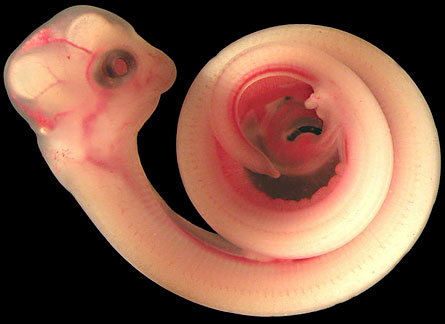“How’d you get those newfangled teeth?” hissed the petite garter snake to the venomous cobra. “Same way that you got yours,” cobra replied. All fangs — no matter their size, shape or position — descend from a single evolutionary event, new evidence from snake embryos suggests.


“I’m sky high on this piece of work,” comments Ken Kardong, a biologist at WashingtonStateUniversity in Pullman, who has been studying snake evolution for more than 30 years. “This will become a textbook example in evolutionary biology identifying how development produces diversity in the natural world that natural selection can then act on.”
The new study, led by Freek Vonk of LeidenUniversity in The Netherlands, reveals that snakes didn’t reinvent the wheel with each new version of their venom-delivery systems. The report appears in the July 31 Nature.
“They’ve shown there is a single underlying way of building things that has been elaborated different ways, in different groups,” comments biologist Rick Shine of the University of Sydney in Australia.
Dagger-sharp frontal fangs allow cobras and vipers to prey on feisty mammals such as the large desert rat. Garter snakes, corn snakes and others that hunt less volatile creatures do just fine with fangs in the back of their mouth. What confused biologists, however, was learning that the front-fanged snakes don’t fall into a neat group. In the snake tree of life, rear-fanged snakes are scattered on evolutionary branches in between the cobras and the more recently evolved vipers, which indicates that fangs evolved at least a couple of times on separate branches leading to front-fanged snakes.
The assumption of multiple origins is problematic for evolutionary biologists who prefer to find that complex structures like fangs — multi-part weapons consisting of a sharp tooth connected to a venomous gland — don’t just come and go. If they did, fangs presumably would have popped up in other vertebrates. They haven’t.
The distinction between front-fanged snakes and rear-fanged snakes goes back centuries, Shine says. Most studies focus on fully formed fangs. The new study by Vonk is the first in decades to compare how front and back fangs develop within snake embryos.
As snake embryos develop within eggs, their cells multiply and differentiate. Genes direct cells to take on different identities — an eye will form here, a tongue there. In snake “gums,” a gene called sonic hedgehog lays out the toothy part of the body plan.
Vonk and his collaborators collected hundreds of snake eggs, and slowly began the arduous process of tracking down where sonic hedgehog was being expressed in the mouths of the embryos. Finding snake nests in the wild is incredibly hard, Vonk says. So the group sought out eggs from hobbyists around the world who raise snakes in captivity.
After examining multiple embryos from eight snake species — some with fangs in front, some with fangs in back, some without fangs — Vonk’s team discovered that the initial plans for fang formation consistently began at the back of the mouth, even in front-fanged snakes.
“When you get a finding like that, where the fangs in all kinds of adults come from the same place in the embryo … it supports the idea that there’s an evolutionarily common origin for the fang and that it hasn’t evolved totally independently,” explains Michael K. Richardson of Leiden University.
A critical event millions of years ago set the stage for fangs to form, the researchers suggest. Tooth-forming tissue at the back part of the jaw became uncoupled from the front part, so that the back area was free to change while the front part still grew teeth that could grab prey. Thus the primitive snake could survive while the back part was under construction.
“Nature took the easiest path,” says Richardson, “and the easiest path is not to evolve a whole new structure but to just move this wonderful biological weapon around in the skull to suit different lifestyles.” Cobra fangs are rather stationary compared with rattlesnake fangs, which lie flat against the roof of their mouths and swing downward like a kickstand to pierce prey. Stiletto snake fangs, on the other hand, snap out of their mouths horizontally. Yet all those frontal fangs grew from tissue at the back of the mouth in an early snake ancestor. Embryonic fang development is a relic of that early process, says Vonk.
Early snakes with a mouth more like today’s fangless boa constrictors diverged from lizards some 100 million years ago, says Vonk. Fossils of fanged snakes date back about 24 million years. The researchers found that boas bear just one section of dental tissue, while fanged snakes all have two. So, they propose, in those millions of years between the fangless and fanged snakes, dental tissue split and in doing so, allowed fangs to form. In turn, fanged snakes feasted, flourished and diversified. Of the 2,700 species of snakes, 2,300 are in the fang-bearing group.






